Embark on a pursuit for understanding the intricacies of dealing with ingrown toenails at home. Join the growing number of individuals searching for clear, step-by-step guidance on how to safely trim an ingrown toenail. This informative piece aims to provide a comprehensive overview of the proper technique, the essential tools needed, and preventive measures to take. Whether you’re seeking to overcome this common issue on your own or with professional assistance, we’ve got you covered
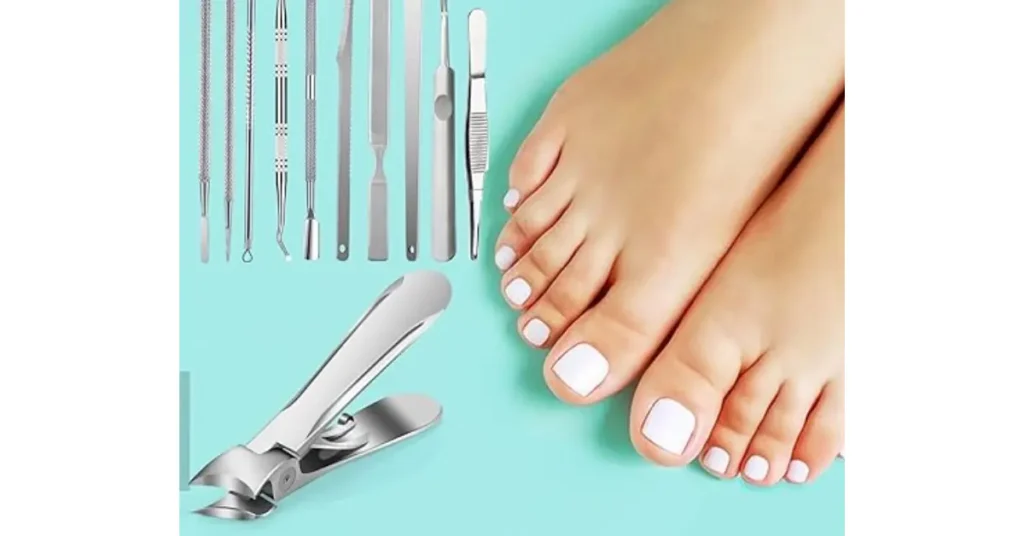
Table of Contents
The common, curly ingrown toenail
Teenagers and adults between 20 to 40 years old often face the painful ordeal of an ingrown toenail, or onychocryptosis, mostly affecting the big toe a common condition known to afflict even with the most diligent care.

How to cut thick toenails
Thick toenails, often caused by fungal infection, psoriasis, or injury from tight-fitting shoes, require care to properly cut. Start by soaking your feet in warm water to soften the nails, then dry them well. Using nail clippers, make small cuts and ensure you cut straight across to avoid the nail becoming ingrown. Don’t round off the corners and use an emery board to smooth edges and prevent snags. If it’s too painful, or difficult to manage safely without help, always ask a doctor for advice.
How to cut toenails with fungus
When cutting toenails with fungus, the process involves using medical-grade toenail clippers instead of standard clippers to handle the thickness. Ensure a longer foot soak, about 20 to 30 minutes, before attempting to cut. After use, disinfect your clipper to avoid further spread of the fungal infection, and if complications occur, see a doctor.
Is it safe to cut an ingrown toenail at home?
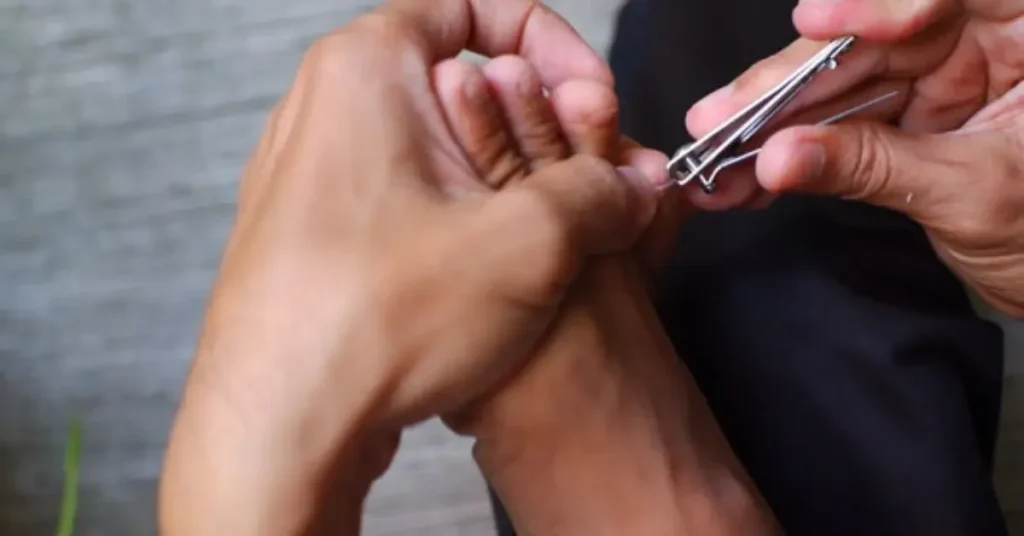
Cutting an ingrown toenail at home can worsen the problem or cause infections; it’s best to seek professional care.
People at risk of nails becoming ingrown should try trimming nails straight across to avoid rounded or pointed edges, and not cutting too short.
It’s crucial to leave nails long enough so that the corners lie against the skin loosely. If a toenail is already ingrown, very painful, or getting worse with signs of infection, Healthcare professionals recommend seeking a doctor’s advice.
The American College of Foot and Ankle Surgeons discourages “bathroom surgery”, as repeatedly ingrowing nails can become worse over time, and the American Academy of Dermatology highlights the dangers of digging out or clipping which can break the skin and allow bacteria and microbes to enter, potentially causing a painful infection.
Treating ingrown toenails at home
People seeking to treat an ingrown toenail at home can take over-the-counter medications, like acetaminophen or ibuprofen, for pain relief, and try numbing creams or sprays to ease discomfort from any underlying infection. It’s beneficial to soak the foot in warm water several times a day, and adding Epsom salt may help reduce swelling. Afterward, gently massage the area to boost blood flow, enhancing the healing process. Always dry the foot post-soaking and apply antibacterial cream to reduce the risk of infection. While some may recommend placing cotton or dental floss under the ingrown portion to relieve pressure, it’s cautioned that this could increase the risk of infection if it does not relieve pain.
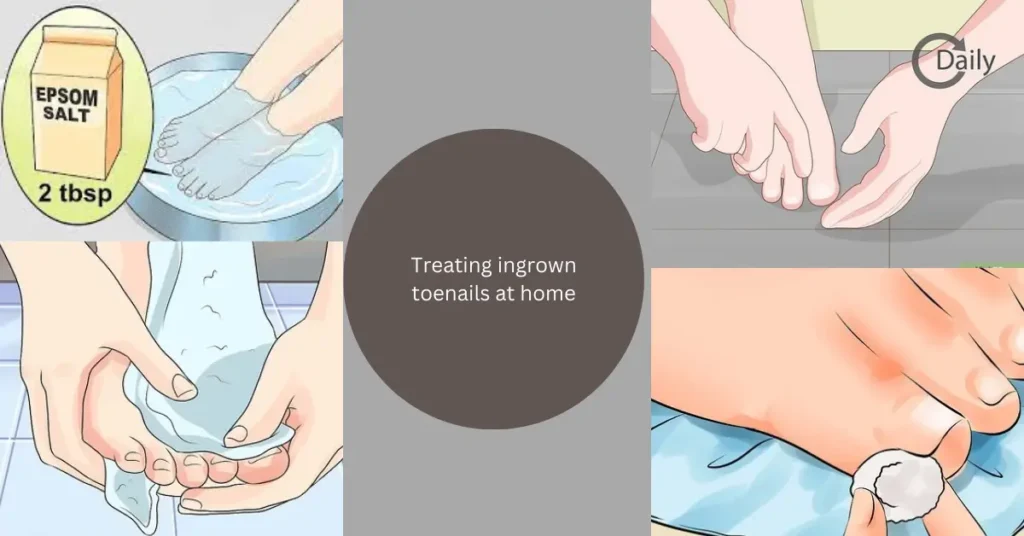
Steps to cut an ingrown toenail
Confronting the challenge of an ingrown toenail means adopting a systematic approach for proper removal. Breaking down the process into distinct steps helps to effectively address the issue, minimizing discomfort and the risk of complications.
Preparing the foot and tools
Before the toenail-cutting process, always prepare by thoroughly cleaning the foot and ensuring you have good toenail clippers and all necessary tools on hand. Maintain hygiene for a clear view of the nail area, and remember that properly sanitized nail clippers or scissors are pivotal in helping to prevent bacteria that could lead to infections.
Softening the toenail
Softening the affected toenail involves immersing the foot in a basin of warm, soapy water for approximately 10 to 15 minutes to cleanse, soften the nail, and make the skin pliable, easing subsequent steps and reducing nail splitting in the process.
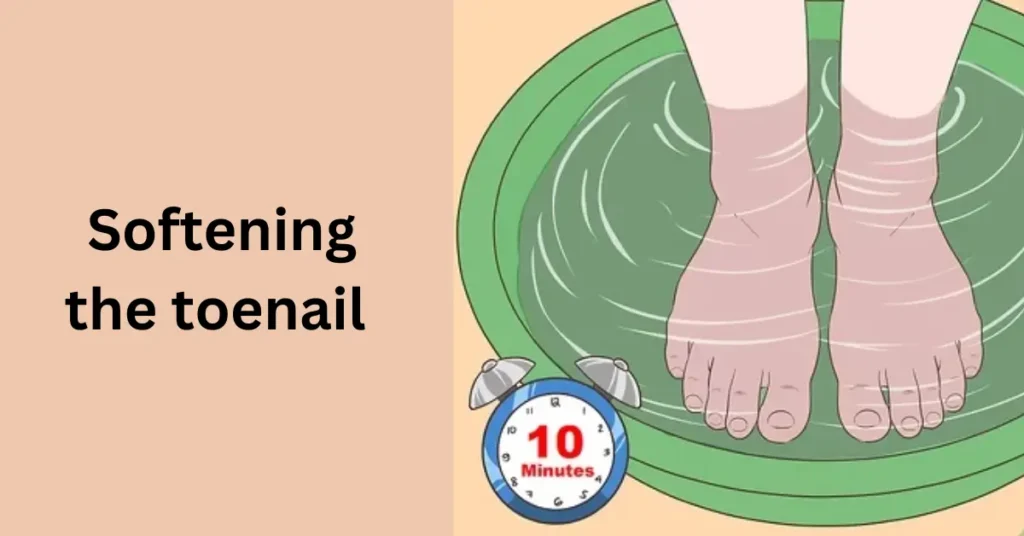
Lifting the ingrown edge
After softening, lift the ingrown edge of the toenail carefully with sanitized tools designed for the task. This is a pivotal step as it grants access to the affected area, allowing for precise trimming while you exercise patience to avoid further discomfort or injury during the trimming process.
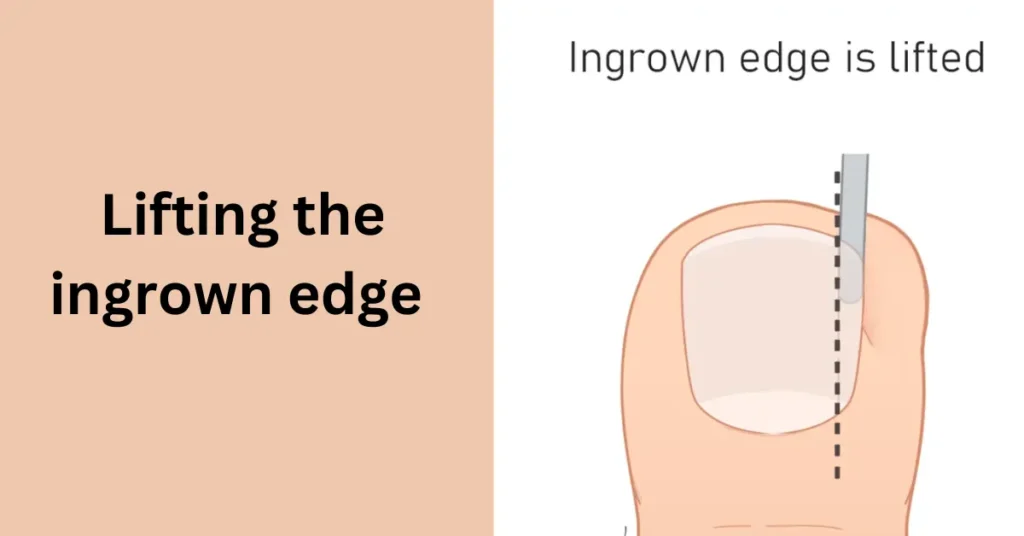
Trimming the nail carefully
Once the ingrown edge is lifted, carefully trim the toenail, ensuring you maintain a straight-line cut across while avoiding any curved or rounded edges to prevent the nail from growing into the surrounding skin. It’s prudent to trim conservatively to the appropriate length, as overly short nails can increase the risk of future ingrowth. By meticulously following these steps in a methodical approach, you can confidently address the issue, remembering that a thoughtful, patient approach is key to toenail care and overall foot health and comfort.
Ingrown toenail trimming tips
Mastering the art and technique of trimming ingrown toenails includes crucial tips that can elevate your toenail care routine. To effectively manage this, maintain tool cleanliness, avoid rounding the nail excessively, and always trim after softening the nail with a soak.
Choosing the right tools
Selecting appropriate tools for toenail trimming, like nail clippers or scissors designed specifically for toenails, is a fundamental step. Make sure your tools are clean, sharp, and sanitized to ensure precision and reduce the risk of nail breakage or injury during the trimming process.
Maintaining hygiene
Hygiene is critical, playing a vital role in preventing infections and promoting overall foot health. Always ensure feet are clean and dry and tools thoroughly cleansed with soap and water, then disinfected with a sanitizing solution, a simple practice that significantly reduces the risk of introducing harmful bacteria.
Avoiding common mistakes
- Awareness of common mistakes to avoid unnecessary discomfort and complications.
- Over Trimming: Keeping nails excessively short increases the chances of ingrown toenails; aim for moderate length.
- Rounding the Edges: Avoid rounding the edges of the toenail; a straight-line cut minimizes the risk of growing into the skin.
- Digging into the Corners: Avoid digging into corners to prevent injury and potential infection; always trim straight across.
When to seek professional help for ingrown toenails
Addressing ingrown toenails can be complex, and it’s essential to be vigilant for potential complications to ensure your foot’s well-being. Knowing when to seek professional help is crucial; if home care is insufficient and symptoms like pain or signs of infection persist, it’s time for expert intervention.
Signs of infection or complications
- Staying alert to signs of infection or complications with an ingrown toenail is key.
- Indicators to watch for include Redness and swelling in the area, which can signify an infection.
- The presence of Pus Formation or discharge is a clear sign of infection.
- Increased Pain that intensifies and doesn’t subside after home care may indicate an underlying issue.
Consulting a healthcare provider
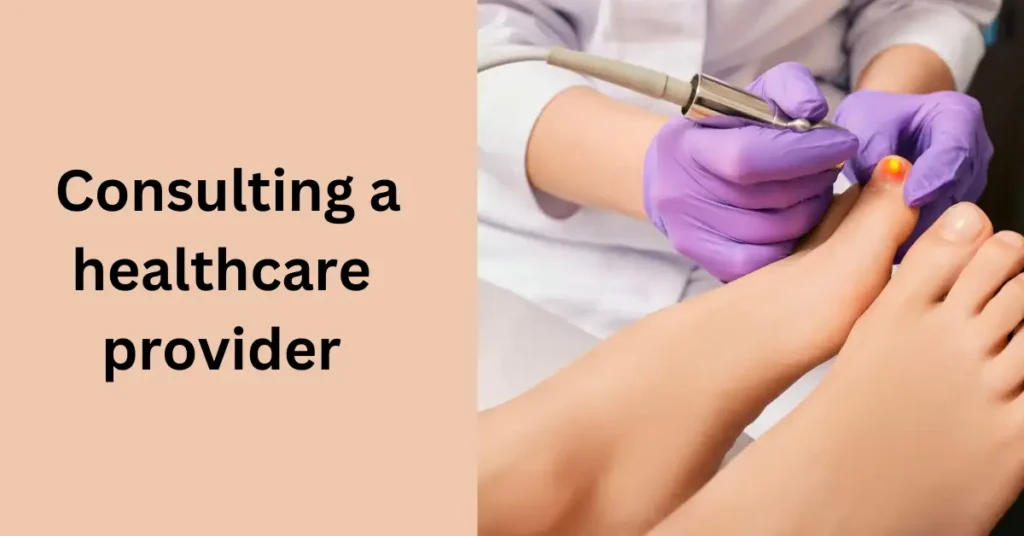
When home care isn’t enough to effectively and safely trim an ingrown toenail, it’s essential to seek professional assistance. If you notice signs of infection or experience persistent discomfort, consulting a healthcare provider is recommended. A medical professional will accurately diagnose the severity of your issue and can recommend appropriate treatment, which may include prescribing antibiotics for any infections, or they may perform a minor procedure to remove the ingrown portion safely.
Preventing ingrown toenails
Preventing ingrown toenails involves adopting proactive habits and incorporating practices into your routine that prioritize foot health and care, which can significantly reduce the likelihood of this common issue.
Proper toenail-trimming habits
- Cultivating proper toenail-trimming habits is key to preventing ingrown toenails.
- Always follow guidelines to trim toenails straight across.
- Avoid rounding the edges to minimize the risk of the nail growing into the skin.
- Important to keep a moderate nail length; trimming excessively short nails can lead to ingrowth.
- Aim for a length that extends just beyond the tip of the toe for optimal nail health.
Choosing appropriate footwear
- The shoes you wear play a crucial role in preventing ingrown toenails.
- Opt for footwear that supports foot health.
- Choose shoes with adequate room to ensure space for toes.
- This helps in preventing undue pressure on the nails.
- Avoid tight-fitting shoes that squeeze the toes and can encourage nails to grow into the skin.
Maintaining foot hygiene
- Practicing good foot hygiene is essential for keeping ingrown toenails at bay.
- Make it a habit to regularly wash and dry your feet to maintain cleanliness.
- Cleanse your feet daily to prevent the accumulation of dirt and bacteria.
- Avoid excess moisture as it can soften nails, making them more prone to ingrowth.
Special considerations: ingrown toenail care for diabetics
Individuals with diabetes require a unique approach to ingrown toenail care due to potential complications with compromised foot health, underscoring the importance of safe practices in toenail trimming.
Importance of foot care for diabetics
- For those with diabetes, maintaining foot health is paramount.
- They face reduced circulation and nerve sensitivity, making them susceptible to foot problems.
- Ingrown toenails in diabetics can lead to serious infections.
- Practicing diligent foot care is essential to prevent complications.
- Such complications can impact overall health significantly.
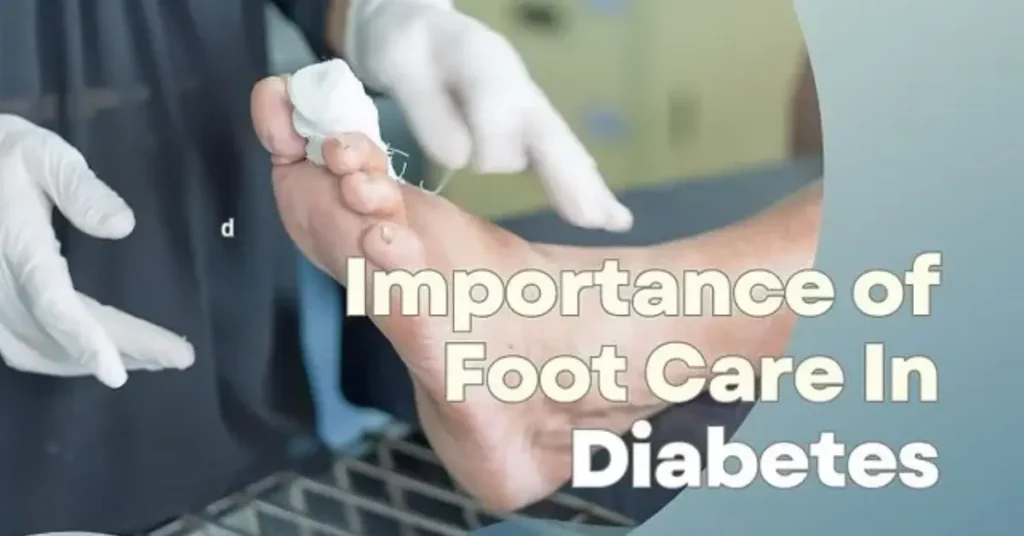
Safe practices for toenail trimming
- Consult your healthcare provider for personalized guidance before attempting any home toenail care, especially if you have considerations such as diabetes; they will inform you if it’s advisable to proceed.
- Once cleared by a professional, use tools designed for gentle trimmings, like specialized diabetic nail clippers or scissors, to prevent harm to the nail bed.
- Always trim with the utmost care, and avoid over-trimming; cutting the nails too short can lead to ingrowth.
- Aim to trim conservatively and maintain a gentle curve at the edges of the toenails, avoiding the creation of sharp corners.
- In my unique foot health journey, I’ve learned the importance of these safe practices. Helping my uncle with his toenails required specific condition-related considerations and the right tools. Through this, we have managed to prevent further ingrowth without injuring the nail bed.
Mistakes to avoid when cutting ingrown toenails
Navigating the process of managing ingrown toenails calls for precision and caution to smoothly avoid crucial mistakes in the toenail-cutting procedure.
Over-trimming and Excessive Pressure
In the quest to find solutions for ingrown toenails, a common mistake is over-trimming the toenail, driven by the desire to alleviate discomfort. This can leave excessively short nails that increase the risk of ingrowth, as the nail lacks the necessary room to grow, potentially curving back into the skin. Furthermore, applying excessive pressure during cutting not only causes injury to the delicate nail bed but also escalates the pain, bleeding, and the potential for infection.
Using Improper Tools
Using improper tools for toenail trimming can cause the nail to splinter or tear, worsening an ingrown nail and injuring the surrounding skin. Mastering safe trimming techniques with the right tools helps prevent complications and ensures pain-free outcomes. Understanding these guidelines allows for effective preventive measures that safeguard your feet.
Conclusion
In conclusion, proper management and prevention of ingrown toenails involve careful trimming techniques, the right tools, and maintaining good foot hygiene. While this guide offers steps for self-care, it’s crucial to consult a healthcare provider if you encounter severe pain, or signs of infection, or if you have underlying health concerns, ensuring foot health and comfort remain paramount in your daily routine.
FAQ,
How do you cut an ingrown toenail at home?
Surely, to address an ingrown toenail, begin by giving your foot a soothing soak in warm water with Epsom salt to soften the tough area, then carefully push the skin back to expose the nail border, and, maintaining cleanliness, cut the toenail straight across from the edges, avoiding any rounded shapes that could worsen the ingrowth.
Is it OK to dig out an ingrown toenail?
Experts from the American Academy of Dermatology advise against the urge to dig out an ingrown toenail because such actions can often hurt, break the skin, and lead to an infection.
What angle do you cut an ingrown toenail?
It’s important to make sure to cut the toenails straight across and leave the long corners to lie loosely over the skin at the sides, preventing ingrown issues.
